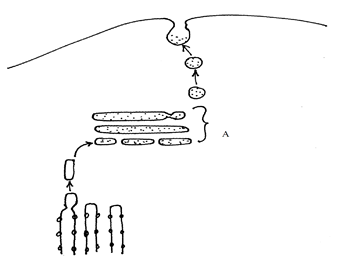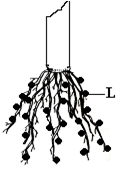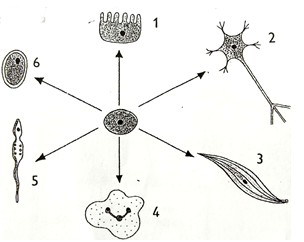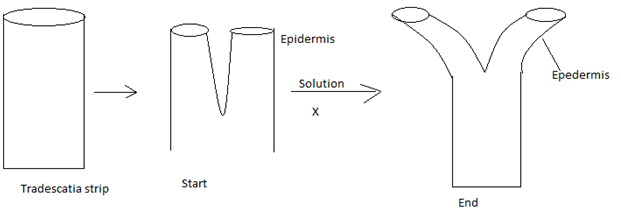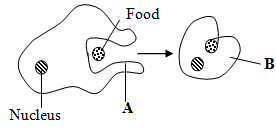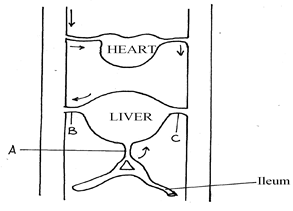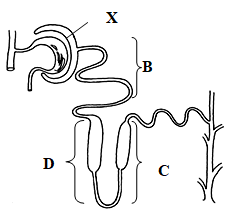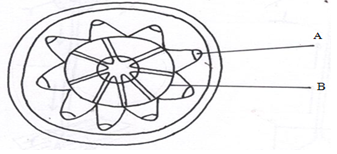Instructions to candidates
- Answer all questions
- Candidates should answer the questions in English.
-
The diagram below represents part of an animal cell. Study it and answer the questions that follow.
- Identify the organelle marked A. (1 mark)
- Give three functions of the organelle named in (a) above (3 marks)
- Name the organism that causes each of the following diseases: (2 marks)
- Amoebic dysentery
- Bilharzia.
- The diagram below represents an organelle.
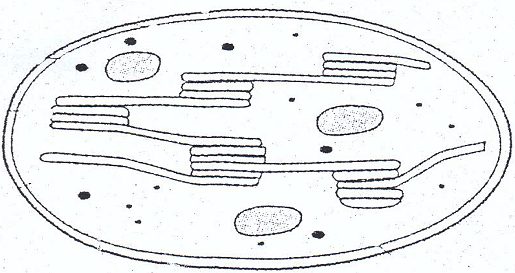
- State the function of the organelle (1 mark)
- Label on the diagram, the parts of the organelle where:
- Oxygen gas is produced as a by product (1 mark)
- Carbon (IV) oxide fixation takes place (1 mark)
- State two functions of bile salts (2 marks)
- Name two classes of phylum Arthropoda whose members have a cephalothorax. (2 marks)
- The diagram below shows part of a leguminous plant.
- Name the structure labelled L. (1 mark)
- Identify the micro-organism that would be contained in structure L. (1 mark)
- What is the significance of the micro- organism named in b) above?(1 mark)
- The following is a portion of a nucleic acid molecule.
G-A-C-U-A-G-A-C-G- Name the type of nucleic acid shown above. (1 mark)
- Give a reason for your answer in b) above. (1 mark)
- Write the base sequence of the strand that is complementary to the portion shown above (1 mark)
- Name the chemical substance in plants that promotes: (3 marks)
- Ripening of fruits
- Flowering in plants.
- Leaf fall in plants.
- Study the diagram below and answer the questions that follow.
- What process is represented by the arrows? (1 mark)
- Identify the type of cell labelled 4. (1 mark)
- Name the tissue formed by each of the following cells. (2 marks)
- 1 …………………….……………………………………………………….
- 3 ……………………….…………………………………………………….
- The equation below represents oxidation of a certain food substance.
C18H36O2 + 26O2 → 18CO2 + 18H2O- Calculate the respiratory quotient of the substance being oxidized. (2 marks)
- Name the likely food substance being oxidized (1 mark)
- State one reason why respiratory quotient values are important to work out (1 mark)
- Study the diagram below and answer the questions that follow.
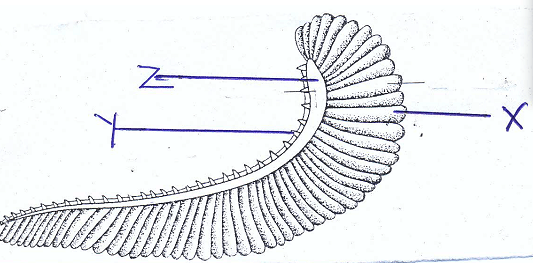
- Name the parts labelled
- Y................................................................................................. (1 mark
- Z................................................................................................. (1 mark)
- Apart from being moist, explain two other adaptations of the part labeled X. (2 marks)
- Name the parts labelled
- A strip of herbaceous Tradescantia was cut longitudinally as shown and placed in solution X. After one hour the strip appeared as shown below.
- What physiological process was being investigated? (1 mark)
- What was the nature of solution X? (1 mark)
- Account for the results at the end of experiment after one hour. (3 marks)
- On a hot sunny day, an adult elephant flaps its ears twice as much as it’s young one. Explain this observation. (3 marks)
- The diagram below shows stages in the process of feeding by amoeba.
- Name the part labelled A. (1 mark)
- Name the process illustrated in the diagram above. (1 mark)
- Identify the type of cell in the human body that exhibits this process. (1 mark)
- A horse has 64 chromosomes in its somatic cells while a donkey has 62. A mule is produced when a horse mates with a donkey. However, the mule is sterile.
- Why is the mule sterile? (1 mark)
- Work out the number of chromosomes in each somatic cell of a mule. (2 marks)
-
- Differentiate between Homologous structures and Analogous structures as used in evolution. (2 marks)
- Explain comparative embryology as an evidence of organic evolution (3 marks)
- The diagram below represents a type of neuron.
- Identify the neuron (1 mark)
- Give a reason for your answer in a) above. (1 mark)
- Using an arrow, indicate on the diagram the direction of an impulse through the neuron. (1 mark)
- The diagram below represents part of the mammalian blood circulatory system and some associated glands.
- Name the blood vessels labelled A and B. (2 marks)
- Which of the blood vessels will have the highest sugar concentration under the following conditions:
- After a heavy meal (1 mark)
- During fasting (1 mark)
- Name one co-factor and one co-enzyme required for blood clotting process to take place normally
- Co-factor…………………………………….……………………… (1 mark)
- Co-enzyme …………………………………….…………………… (1 mark)
- The diagram below represents a structure in a mammalian kidney. Study it and answer the questions that follow.
- Identify the structure. (1 mark)
- State the role of the part labelled C. (1 mark)
- Which hormone is involved in the function of the part labelled D? (1 mark)
- Give three ways in which the part labelled B is adapted for it`s function. (3 marks)
-
- Define pollination. (1 mark)
- Give two factors that hinder self-pollination and self-fertilization in plants (2 marks)
- State the role of insulin hormone in homeostasis (1 mark)
- The diagram below shows some growth in a plant.
- Name the type of growth shown in the diagram. (1 mark)
- Name the part labeled A (1 mark)
- What is the function of the part labeled B? (1 mark)
- Below are two different views of a mammalian bone. Study it and answer the questions that follow.
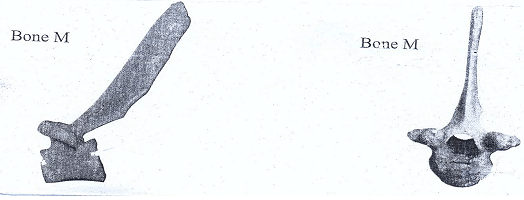
- Identify the bone (1 mark)
- Give a reason for your answer in (a) above (1 mark)
- Explain how plants compensate for their inability to carry out locomotion. (3 marks)
MARKING SCHEME
-
- Golgi apparatus/Golgi body
-
- Packaging of glycol-proteins;
- Formation of Lysosomes
- Secretion of synthesized proteins/Secretion of enzymes;
-
- Entamoeba histolytica;
- Schistosoma japonicum; Acc. Schistosoma spp
-
- Site for photosynthesis;
-
- Grana/granum;
- Stroma;
-
- Emulsification;
- Provide an alkaline medium for the functioning of pancreatic enzyme;
- Neutralize the acidic chyme from the stomach;
MARK 1ST TWO.
-
- Arachnida;
- Crustacea;
-
- Root nodule; Rej Nodule alone.
- Rhizobium bacteria/ Nitrogen fixing bacteria;
- Fixing nitrogen// converts nitrogen into nitrates for the plant;
-
- Ribonucleic acid; Rej RNA
- Presence of Uracil;
- C-T-G-A-T-C-T-G-C;
-
- Ethene/Ethylene;
- Florigen;
- Abscissic acid;
-
- Cell differentiation;
- White Blood Cell;
-
- 1- Epithelium;
- 3 - Smooth muscle;
-
- CO2 produced = 18 ; = 0.69 = 0.7;
O2 consumed 26 - lipids; Acc. Fats & oils
-
- Provides information on the type of substrate oxidised;
- Gives information on the type of respiration/metabolism taking place;
- CO2 produced = 18 ; = 0.69 = 0.7;
-
-
- Y – Gill raker; Rej rakers
- Z – Gill bar;
-
- Thin walled for faster diffusion of respiratory gases;
- Highly vascularised/dense network of blood capillaries to transport the respiratory gases;
-
-
- Osmosis;
- Hypotonic;
- The parenchyma cells on the cut surface absorbed water by osmosis; they became turgid/expanded; the epidermal cells have cuticle and did not absorb water causing the outward bending;
- The adult elephant has a smaller surface area to volume ratio; it loses heat slowly to the environment; hence flaps it’s ears many times (to create air currents around the body) to cool the body; ACC. THE CONVERSE.
-
- Pseudopodium;
- Phagocytosis;
- White blood cells;
-
- Horse and donkey do not belong to the same species;
- 64/2 +62/2 = 32+31; = 63;
-
- Homologous structures have a common embryonic origin but are modified to perform different functions in different species; Analogous structures have different embryonic origins but modified to perform the same function;
- It involves the study and comparison of different embryos; Vertebrate embryos in their early stages of development, show resemblance/similarities (eg all possess a tail); this suggests that they had a common ancestral origin;
-
- Motor neurone;
- Cell body is at one end of the axon; i
NB: From cell body towards the terminal dendrites.
-
-
- A- Hepatic portal Vein;
- B- Hepatic Vein;
-
- A; Acc. Hepatic portal vein.
- B; Acc. Hepatic vein
-
-
- Calcium ion; Rej Ca2+
- Vitamin K;
-
- Nephron;
- Reabsorption of water;
- Aldosterone;
-
- Long and coiled to provide a large SA for reabsorption;
- Coiling reduces the speed of flow of the filtrate and allow more time for reabsorption;
- Cells lining the tubule have numerous mitochondria to provide energy for (active) reabsorption;
- The cells have micro-villi to increase the SA for reabsorption;
- Is supplied with numerous blood capillaries for transportation of reabsorbed substances;
MARK 1ST THREE.
-
- The transfer of pollen grains from an anther to the stigma;
-
- Dioecism;
- Protandry
- Protogyny;
- ) Heterostyly; Acc. Anthers located below the stigma
- Self sterility;
MARK 1ST TWO.
-
- It stimulates the liver cells to convert excess glucose into glycogen/fats for storage;
- It inhibits conversion of glycogen into glucose in the liver;
- Increases oxidation of glucose to yield energy;
-
- Secondary growth;
- A- Primary phloem;
- Cells divide by mitosis to form secondary phloem and secondary Xylem/ For secondary;
-
- Thoracic vertebra;
-
- Long neural spine for attachment of muscles;
- Short transverse processes that bear tubercular facets for articulation with tuberculum of the rib;
- Presence of capitular demifacets on the centrum that articulates with capitulum of the rib;
MARK ANY ONE.
-
- Manufacture their own food by Photosynthesis;
- Pollination is carried out by wind or insects;
- Disperse their fruits/seeds through wind, animals or self-explosive mechanism;
- Absorb/obtain water and mineral salts from the soil by their roots;
MARK ANY THREE.
Join our whatsapp group for latest updates
Tap Here to Download for 50/-
Get on WhatsApp for 50/-
Download Biology Paper 1 Questions and Answers - Bondo Mocks 2021 Exams.
Tap Here to Download for 50/-
Get on WhatsApp for 50/-
Why download?
- ✔ To read offline at any time.
- ✔ To Print at your convenience
- ✔ Share Easily with Friends / Students

